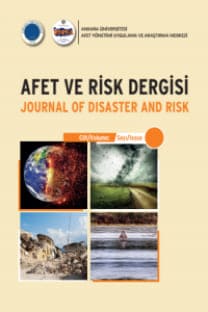Sosyodemografik Özellikler ve Deneyimler Konut Yangınları Davranışları ile Ilişkili Midir? Bir Genç Yetişkin Örneklemi
Davranış, Deneyim, Konut Yangını, Sosyodemografik Özellikler, Genç Yetişkin
Are Sociodemographic Characteristics and Experiences Associated to Behaviours on Residential Fires? A Young Adult Sample
___
- Agran, P.F., Anderson, C., Winn, D., Trent, R., et al. (2003). Rates of pediatric ınjuries by 3-Month ıntervals for children 0–3 Years of age. Pediatrics, 111,683–692.
- Ahrens, M. (2019). Home structure fires. National Fire Protection Association (NFPA).
- Alqassim, M.A., Daeid, N.N. (2014). Fires and related incidents in Dubai, United Arab Emirates (2006–2013). Case Studies in Fire Safety, 2,28-36.
- Bekem, I., Cavus, M., Demirel, F. (2011). Türkiye ölçeğinde yangın istatistikleri üzerine bir çalışma. TÜYAK Yangın ve Güvenlik Sempozyumu ve Sergisi, Available from: http://www.abdurrahmanince.net/TUYAK2011BK.pdf date accessed: 01.09.2019.
- Ballesteros, M.F., Kresnow, M.J. (2007). Prevalence of residential smoke alarms and fire escape plans in the U.S.: Results from the Second Injury Control and Risk Survey (ICARIS-2). Public Health Reports. (Washington, DC : 1974) 122(2),224-31.
- Bowling, C.H., Merrick, J., Omar, A.H (2013). Self-Reported juvenile firesetting: Results from two national survey datasets. Frontiers in Public Health. 1,60.
- Doll, L., Bonzo, S., Sleet, D., Mercy. J., Haas, E. N. (Eds.). (2007). Handbook of ınjury and violence prevention. Springer Science & Business Media.
- Ersoy, S., Kocak, A. (2016). Disasters and earthquake preparedness of children and schools in Istanbul, Turkey, Geomatics, Natural Hazards and Risk, 7,4, 1307-1336, DOI: 10.1080/19475705.2015.1060637
- Fishbein, M., Triandis, H., Kanfer, F.H., Becker, M., Middlestat. S. E., & Eichler. A. (2001). Factors ınfluencing behavior and behavior change. In A. Baum, T. A. Tevenson, & J. E. Singer (Eds.), Handbook of health psychology (pp. 3–16). Mahwah, NJ: Erlbaum Associates.
- Forjuoh, S.N. (2006). Burns in low-and middle-ıncome countries: A review of available literature on descriptive epidemiology, risk factors, treatment, and prevention. Burns. 32(5),529-37.
- Hall, J. R. (2004). The smoking-material fire problem. Quincy, MA: National Fire Protection Association.
- Hall, J.R. (2005). Characteristics of home fire victims. Quincy, MA: National Fire Protection Association.
- Hwang, V., Duchossois, G. P., Garcia-Espana, J. F., & Durbin, D. R. (2006). Impact of a community based fire prevention ıntervention on fire safety knowledge and behavior in elementary school children. Injury prevention, 12(5), 344-346.
- Istre, G.R., McCoy, M., Carlin, D.K., McClain, J. (2002). Residential fire related deaths and ınjuries among children: Fireplay, smoke alarms, and prevention. Injury Prevention, 8(2),128.
- Jonsson, A., Bonander, C., Nilson, F., Huss, F. (2017). The state of the residential fire fatality problem in Sweden: Epidemiology, Risk Factors, and Event Typologies. Journal of Safety Research, 62,89-100.
- Mallonee, S., Istre, G.R., Rosenberg, M., Reddish-Douglas, M., Jordan, F., Silverstein, P., et al. (1996). Surveillance and prevention of residential-fire ınjuries. New England Journal of Medicine., 335(1), 27-31.
- Murray, Christopher J. L., Lopez, Alan D. (1996). World Health Organization, World Bank & Harvard School of public health. the global burden of disease: A comprehensive assessment of mortality and disability from diseases, ınjuries, and risk factors in 1990 and projected to 2020: Summary/edited by Christopher J. L. Murray, Alan D. Lopez. Geneva: World Health Organization. http://www.who.int/iris/handle/10665/41864
- Peden, M. (2008). World report on child ınjury prevention. World Health Organization.
- Ploubidis, G.B., Edwards, P., Kendrick, D., on behalf of the Keeping Children Safe Study G. (2015). Measuring behaviours for escaping from house fires: Use of latent variable models to summarise multiple behaviours. BMC Research Notes, 8,789.
- Spencer L. J., et al. (2018). Global, regional, and national ıncidence, prevalence, and years lived with disability for 354 diseases and ınjuries for 195 countries and territories, 1990–2017: A systematic analysis for the global burden of disease study 2017. The Lancet,1789-1858.
- Sweis, F.K. (2006). Fires and related ıncidents in Jordan (1996–2004). Fire Safety Journal, 41(5),370-6.
- Uygun, M., Inal, E. (2019). Evaluating the firefighting services of Turkey according to emergency and disaster management phases. (Turkish). Journal of Pre-hospital (JPH), 4(1):13-22.
- Warda, L., Tenenbein, M., & Moffatt, M. E. K. (1999). House fire ınjury prevention update. Part 1. A review of risk factors for fatal and non-fatal house fire ınjury. Injury Prevention, 5,145–150.
- Warda, L.J., Ballesteros, M.F. (2008). Interventions to prevent residential fire ınjury. Handbook of injury and violence prevention: Springer, p. 97-115.
- Wood, R. L., Teach, S. J., Rucker, A., Lall, A., Chamberlain, J. M., & Ryan, L. M. (2016). Home fire safety practices and smoke detector program awareness in an urban pediatric emergency department population. Pediatric Emergency Care, 32(11), 763-767.
- Xiong, L., Bruck, L., Ball, M. (2015). Comparative ınvestigation of ‘survival’ and fatality factors in accidental residential fires. Fire Safety Journal, 73,37-47.
- Yalova University Erasmus Office. About Yalova University. Retrieved September 13, 2018, from http://erasmus.yalova.edu.tr/generalinformation/ps85.
- Yentürk, N., Unlü, A., Tarı, E., Ilki, A. (2002). A model proposal for the restructuring of Turkish fire brigade (Türk itfaiye teşkilatının yeniden yapılandırılması için bir model önerisi), ITÜ, AYM. Retrieved September 13, 2018, from https://docplayer.biz.tr/8111-Turk-itfaiye-teskilatinin-yeniden-yapilandirilmasi-icin-bir-model-onerisi.html
- Yayın Aralığı: 4
- Başlangıç: 2018
- Yayıncı: Ankara Üniversitesi
Mehmet Oğuzhan GÜREL, Halim Ferit BAYATA, Osman Ünsal BAYRAK
Amazon Nehri Havzası’nda Sürdürülebilir Sosyoekonomik Kalkınmayı Tehdit Eden Unsurlar
Afet Risklerinin Azaltılmasında Sivil İnsiyatiflerin Rolü: TRI DRR Örneği
Alpaslan Hamdi KUZUCUOGLU, Burçak BAŞBUĞ ERKAN
Altın ve Gümüş Madenciliğinde Siyanür Kaynaklı Kimyasal Kazalarda Acil Durum Yönetimi Örneği
Bülent BÜYÜKKIDAN, Hüseyin GÜMÜŞ
Türkiye’de Anti Nükleer Hareket Örneğinde Risk Söylemi
Türkiye’de Acil Yıkım Yönetim Sistemi: Temel Yaklaşımlar, Elazığ Deprem Deneyimi Ve Öneriler
Bahatti̇n Murat DEMİR, Sami ERCAN, Mustafa AKTAN, Harun ÖZTAŞKIN
Ebru INAL, Edip KAYA, Baki Can METİN, Nüket ERBAYDAR
